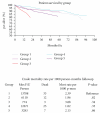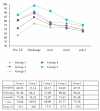A Decade of Experience Using mTor Inhibitors in Liver Transplantation
- PMID: 21461386
- PMCID: PMC3064995
- DOI: 10.1155/2011/913094
A Decade of Experience Using mTor Inhibitors in Liver Transplantation
Abstract
Some studies suggest that Sirolimus (SRL) is associated with an increased risk of death in liver transplant recipients compared to treatment with calcineurin inhibitors (CNIs). We compared patients who received SRL or CNI in the first year after liver transplant. Our database included 688 patients who received a liver transplant. The patients were divided into groups. (1) CNI + MPS (mycophenolate sodium) at time of discharge. (2) CNI + MPS at time of discharge; SRL was added within the first 6 months and continued through the first year. (3) CNI + MPS at time of discharge; SRL was added within the first 6 months and discontinued before the first year. (4) SRL as primary immunosuppression. (5) SRL as primary immunosuppression and discontinued before the first year. We used mortality and graft loss as the primary measures of outcome. We also quantified renal function using the change in glomerular filtration rate (GFR), the presence of biopsy proven acute cellular reject (ACR), and steroid-resistant rejection (SRR). There were no significant differences in mortality or graft loss. There was no difference in patient or graft survival. Patients that received SRL as primary immunosuppression had 50% less rejection compared to controls.
Figures




Similar articles
-
Calcineurin inhibitor-free mycophenolate mofetil/sirolimus maintenance in liver transplantation: the randomized spare-the-nephron trial.Liver Transpl. 2013 Jul;19(7):675-89. doi: 10.1002/lt.23658. Liver Transpl. 2013. PMID: 23775875 Clinical Trial.
-
Replacement of calcineurin-inhibitors with sirolimus as primary immunosuppression in stable cardiac transplant recipients.Transplantation. 2007 Aug 27;84(4):467-74. doi: 10.1097/01.tp.0000276959.56959.69. Transplantation. 2007. PMID: 17713429 Clinical Trial.
-
Conversion from calcineurin inhibitors to sirolimus maintenance therapy in renal allograft recipients: 24-month efficacy and safety results from the CONVERT trial.Transplantation. 2009 Jan 27;87(2):233-42. doi: 10.1097/TP.0b013e3181927a41. Transplantation. 2009. PMID: 19155978 Clinical Trial.
-
Calcineurin inhibitor avoidance and withdrawal for kidney transplantation: a systematic review and meta-analysis of randomized controlled trials.Transplant Proc. 2014 Jun;46(5):1302-13. doi: 10.1016/j.transproceed.2014.02.010. Transplant Proc. 2014. PMID: 24935293
-
Treatment strategies in pediatric solid organ transplant recipients with calcineurin inhibitor-induced nephrotoxicity.Pediatr Transplant. 2006 Sep;10(6):721-9. doi: 10.1111/j.1399-3046.2006.00577.x. Pediatr Transplant. 2006. PMID: 16911497 Review.
Cited by
-
Endoscopic retrograde cholangiopancreatography and liver biopsy in the evaluation of elevated liver function tests after liver transplantation.World J Hepatol. 2021 Jan 27;13(1):132-143. doi: 10.4254/wjh.v13.i1.132. World J Hepatol. 2021. PMID: 33584992 Free PMC article.
-
Erzhi Pill® Repairs Experimental Liver Injury via TSC/mTOR Signaling Pathway Inhibiting Excessive Apoptosis.Evid Based Complement Alternat Med. 2017;2017:5653643. doi: 10.1155/2017/5653643. Epub 2017 May 30. Evid Based Complement Alternat Med. 2017. PMID: 28638431 Free PMC article.
-
Acute allograft rejection in liver transplant recipients: Incidence, risk factors, treatment success, and impact on graft failure.J Int Med Res. 2018 Sep;46(9):3979-3990. doi: 10.1177/0300060518785543. Epub 2018 Jul 12. J Int Med Res. 2018. PMID: 29996675 Free PMC article.
-
The impact of immunosuppressant therapy on the recurrence of hepatitis C post-liver transplantation.Int J Health Sci (Qassim). 2018 Jul-Aug;12(4):78-87. Int J Health Sci (Qassim). 2018. PMID: 30022908 Free PMC article.
-
The Role of mTOR Inhibitors in Liver Transplantation: Reviewing the Evidence.J Transplant. 2014;2014:845438. doi: 10.1155/2014/845438. Epub 2014 Feb 25. J Transplant. 2014. PMID: 24719752 Free PMC article. Review.
References
-
- Campsen J, Zimmerman MA, Trotter JF, et al. Sirolimus and liver transplantation: clinical implications for hepatocellular carcinoma. Expert Opinion on Pharmacotherapy. 2007;8(9):1275–1282. - PubMed
-
- Firpi RJ, Tran TT, Flores P, et al. Sirolimus-induced hyperlipidaemia in liver transplant recipients is not dose-dependent. Alimentary Pharmacology and Therapeutics. 2004;19(9):1033–1039. - PubMed
-
- Fisher A, Seguel JM, de la Torre AN, et al. Effect of sirolimus on infection incidence in liver transplant recipients. Liver Transplantation. 2004;10(2):193–198. - PubMed
-
- Kniepeiss D, Iberer F, Grasser B, Schaffellner S, Tscheliessnigg KH. Sirolimus and mycophenolate mofetil after liver transplantation. Transplant International. 2003;16(7):504–509. - PubMed
-
- McAlister VC, Peltekian KM, Malatjalian DA, et al. Orthotopic liver transplantation using low-dose tacrolimus and sirolimus. Liver Transplantation. 2001;7(8):701–708. - PubMed
LinkOut - more resources
Full Text Sources
Miscellaneous

